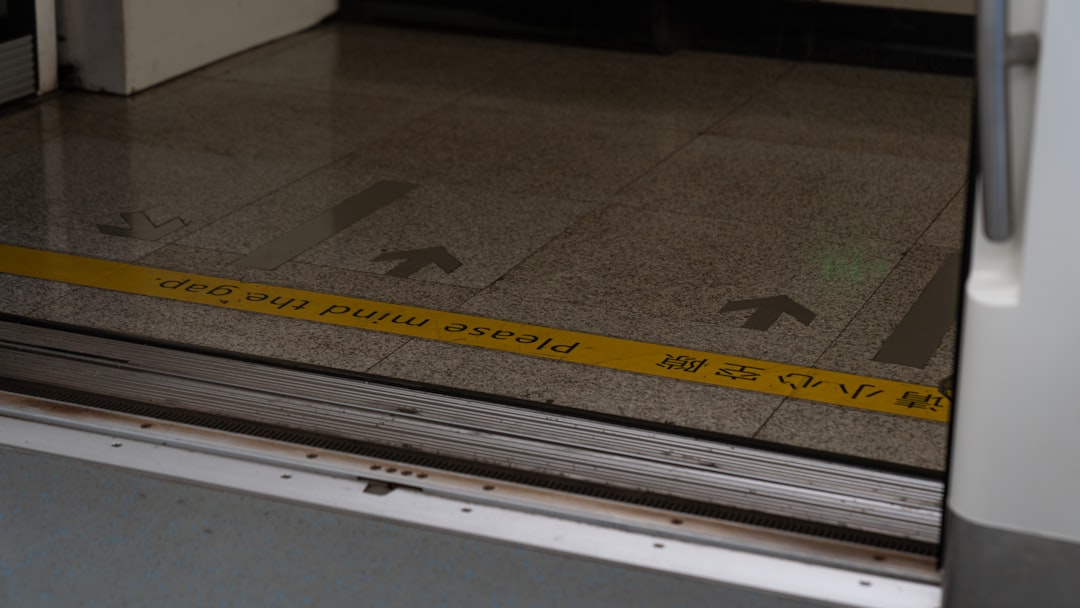Scratch resistant floors: Top 3 Ultimate Choices
Why Scratch-Resistant Flooring Is Essential for Modern Living
Scratch resistant floors are no longer a luxury; they’re a necessity for today’s active households. With pet claws, furniture movement, and daily foot traffic, the right flooring can prevent costly replacements.
Top Scratch-Resistant Flooring Options:
- Porcelain and Ceramic Tile – Most scratch-resistant option available
- Luxury Vinyl Plank (LVP) – Best balance of durability and comfort
- Stone Plastic Composite (SPC) – Superior scratch resistance with waterproofing
- High-AC Rated Laminate – Cost-effective with good scratch protection
- Engineered Hardwood – Natural beauty with improved durability
The global flooring market is projected to reach $745.8 billion by 2030, with scratch-resistant options leading the growth, reflecting a clear demand for durable surfaces. Floors take a beating.
“Scratch-resistant” doesn’t mean “scratch-proof.” Even the toughest floors can be damaged by sharp objects or heavy grit. The key is choosing materials that resist everyday wear from normal household activities.
As one flooring professional noted, “Floors need to stand up to life’s daily adventures, especially with a playful pup.” From muddy paws to dropped utensils, your floors see it all.
I’m Ramy Saber, a Civil Engineer and founder of الأميرة سندريلا A&C, where I’ve spent years helping clients choose scratch resistant floors that combine durability with modern design for homes, offices, and hotels. Through my construction and facility management experience, I’ve seen how the right flooring choice can make or break a space’s long-term functionality.
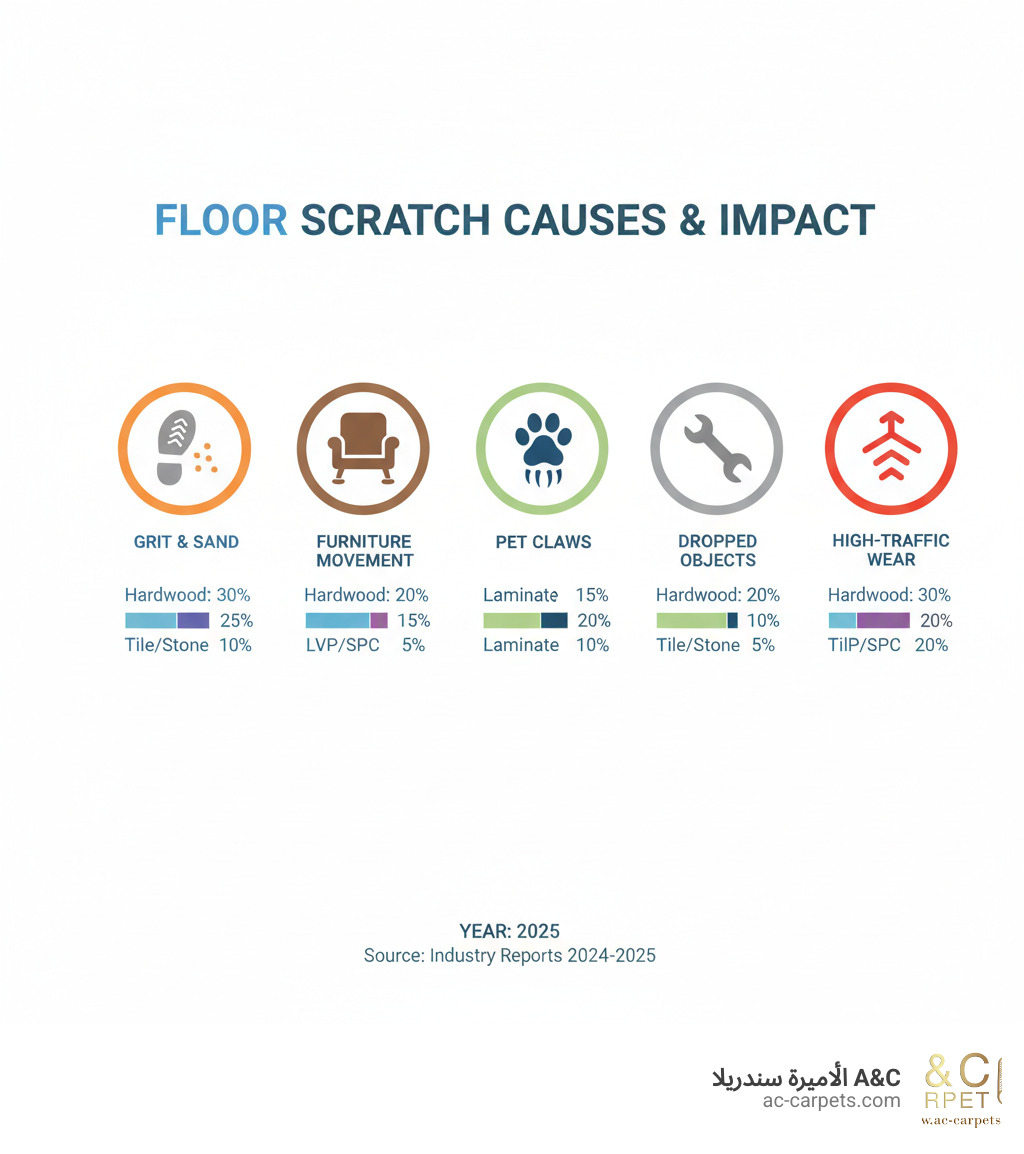
The Top Tiers of Durability: Tile and Stone
When it comes to scratch resistant floors, nothing beats the durability of ceramic and porcelain tiles. These materials are tough, reliable, and ready for whatever life throws at them.
Porcelain tile is the superstar here. Made from denser, more refined clay and fired at scorching temperatures, it creates a surface that’s incredibly hard and less porous than regular ceramic. For maximum scratch protection, unglazed porcelain is your best friend; if it does get a tiny chip, you won’t even notice because the color goes all the way through.
Pro tip: For true scratch resistance, a tile should score above 6 on the Mohs hardness scale—harder than most kitchen knives.
Natural stone options like granite bring both beauty and brawn to your floors. Granite resists scratches while giving you a luxurious look that never goes out of style. Just remember that while granite and travertine can handle daily abuse, softer stones like marble might show their battle scars over time.
The benefits of choosing tile and stone are impressive: extreme hardness that resists sharp objects, water resistance that makes spills no big deal, and easy cleaning. These floors can last for decades when properly installed, making them a smart long-term investment.
However, there are trade-offs. These floors can feel cold and hard underfoot. A heavy dropped object might cause cracking on an uneven subfloor, and grout lines require regular cleaning to stay fresh.
When shopping for tiles, pay attention to the PEI rating—it’s like a report card for durability. This scale runs from Class 1 (for light residential areas) up to Class 5 (for heavy commercial traffic). For busy family homes, aim for higher PEI ratings to ensure your floors can handle the chaos.
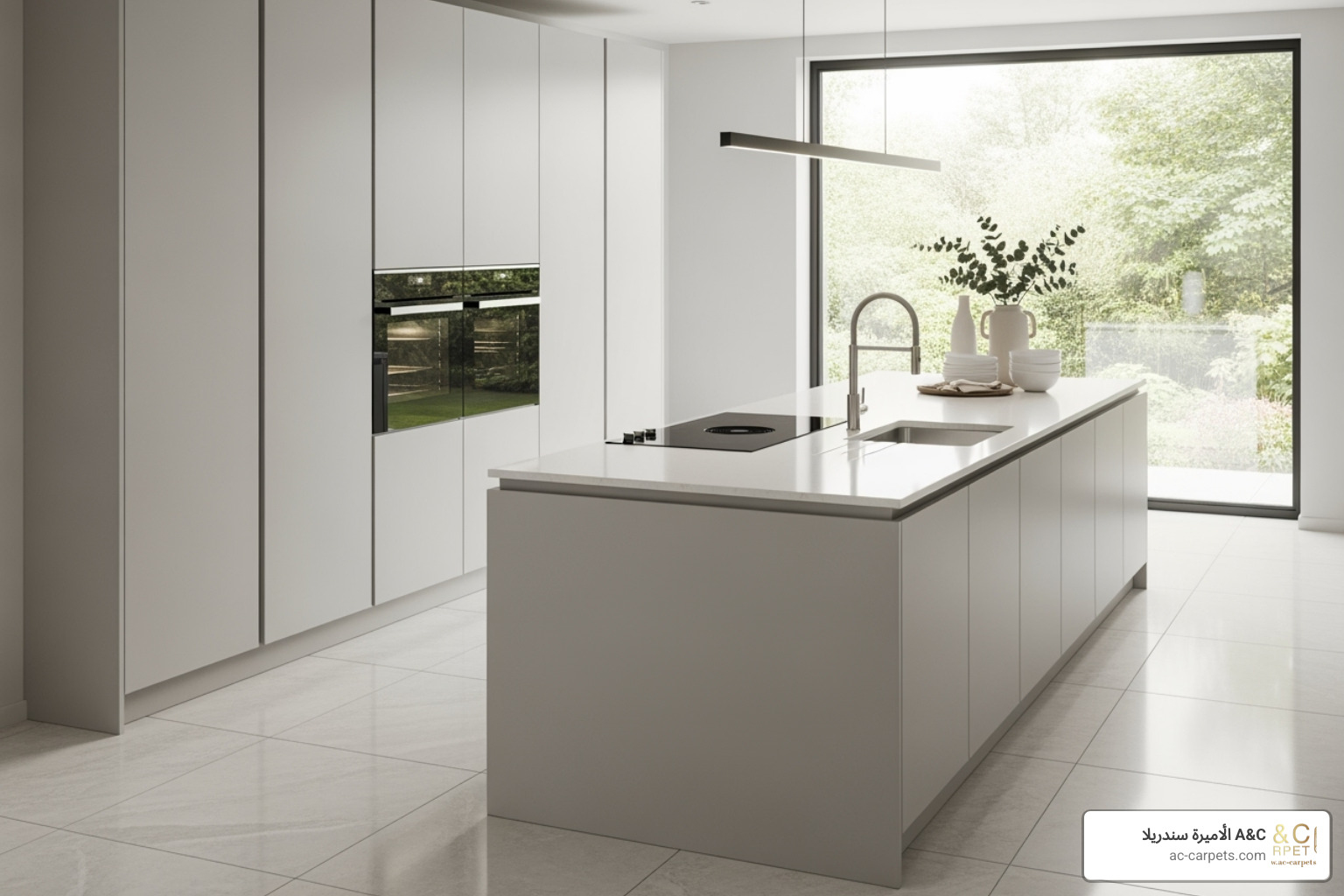
At الأميرة سندريلا A&C, we’ve seen how the right tile choice can transform a space from worry-inducing to worry-free. These truly are among the best scratch resistant floors you can choose for ultimate protection.
The Resilient Contenders: Luxury Vinyl and Laminate
Beyond tile and stone, luxury vinyl and laminate have revolutionized modern homes. These aren’t old-fashioned vinyl floors; they are sophisticated surfaces that convincingly mimic natural materials.
The market for these materials is booming. The global laminate flooring market hit USD 11.5 billion in 2022 and is growing steadily, while luxury vinyl’s growth is even more explosive. Homeowners value their blend of beauty, durability, and practicality.
When it comes to scratch resistant floors, both luxury vinyl and laminate bring their A-game. While not as hard as porcelain, they excel in multiple areas that matter to families.
| Feature | Luxury Vinyl Flooring (LVT/LVP) | Laminate Flooring |
|---|---|---|
| Scratch Resistance | Good to excellent, depending on wear layer thickness and core (SPC often better) | Excellent, especially with higher AC ratings (AC4/AC5) |
| Water Resistance | Very good to waterproof (LVP/SPC) | Good (water-resistant), but not waterproof; vulnerable to standing water |
| Cost | Mid-range to high-end | More budget-friendly, mid-range for high-quality |
| Feel | Softer, more resilient, quieter underfoot | Harder, can be louder underfoot, less forgiving |
| Aesthetics | Highly realistic wood/stone looks, often with texture | Realistic wood/stone looks, can sometimes feel less authentic than LVT/LVP |
Luxury Vinyl Tile (LVT) and Luxury Vinyl Plank (LVP) have become the darlings of busy households. These floors convincingly mimic the grain of hardwood or patterns of natural stone. LVT and LVP are ideal for homes with active kids and pets, easily handling high traffic, muddy paws, and dropped toys.
Laminate flooring takes a slightly different approach to durability. It offers excellent scratch resistance, especially with high AC ratings. The only thing it asks in return? Keep standing water away from it, and it’ll serve you faithfully for years.
Both options represent the evolution of Durable and comfortable floors that modern families deserve. They prove you don’t have to choose between style and substance.
Key Features of Scratch-Resistant Vinyl Flooring
Luxury vinyl’s durability comes from its layered construction, where each layer serves a protective function.
The star of the show is the wear layer. This transparent protective coating sits on top, acting as the floor’s bodyguard against scratches, scuffs, and daily wear. The thickness of this layer is measured in “mils” (thousandths of an inch), and thicker is better.
A 12 mil wear layer is good for typical homes, but for households with kids, pets, or high traffic, we recommend 20 mil or higher. Premium options offer commercial-grade 30 mil wear layers for maximum toughness.
Many manufacturers also boost their wear layers with Aluminum Oxide, an extremely hard mineral that creates a tough surface, keeping scratches at bay and helping your floors look new for years.
The core beneath matters too. You’ll encounter two main types:
SPC (Stone Plastic Composite) core is the tough guy of the vinyl world. Made from limestone powder, PVC, and stabilizers, it creates a dense, rigid foundation. This rigidity means superior scratch resistance and stability, making SPC our go-to recommendation for maximum durability.
WPC (Wood Plastic Composite) core takes a softer approach. Built from wood pulp and plastic composites, it offers a warmer, more comfortable feel with excellent sound absorption. While still highly scratch resistant, it’s less rigid than SPC, making it perfect for areas where comfort is key.
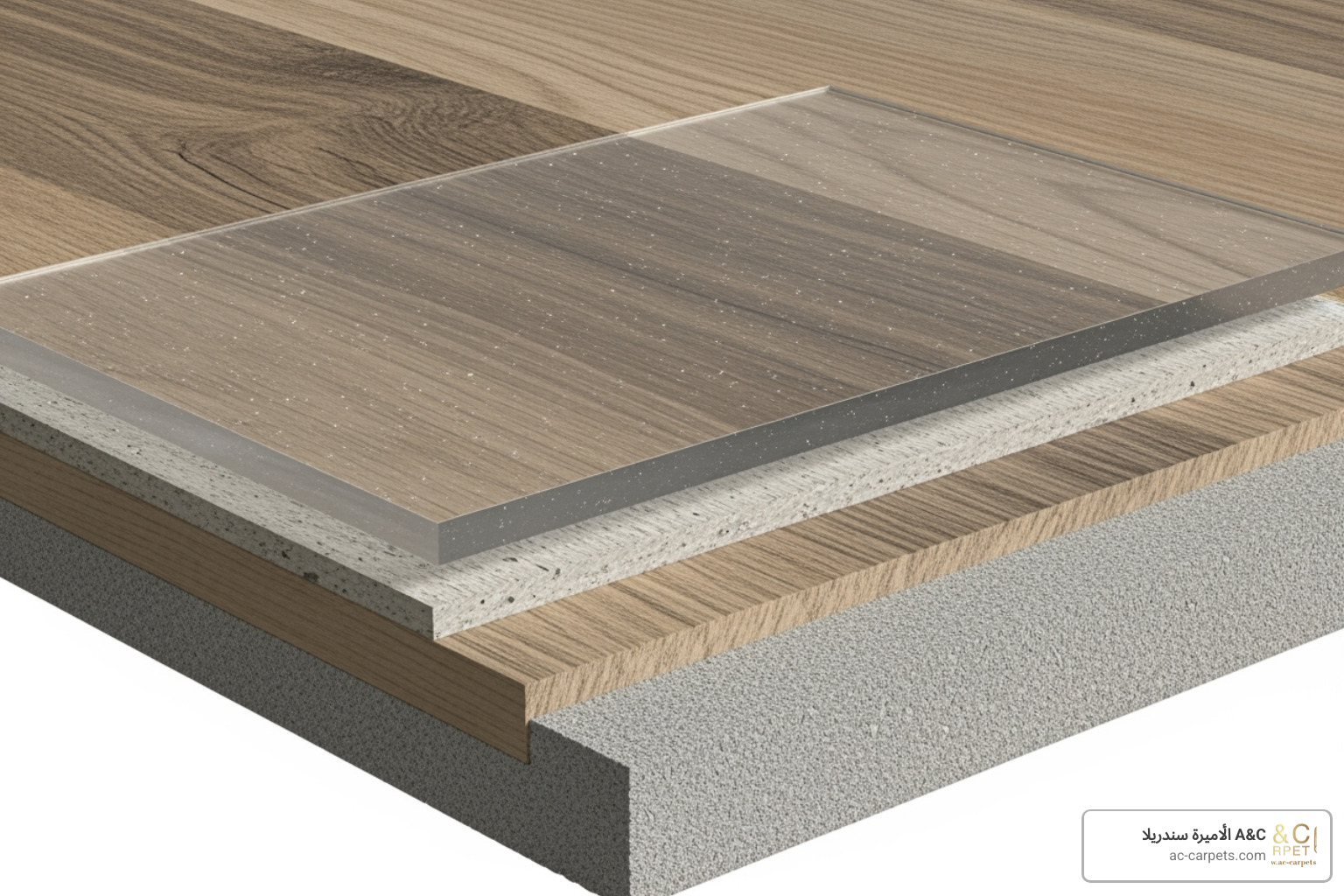
When shopping for vinyl, a robust wear layer with protective coatings and a sturdy core creates floors that can handle any busy household.
Understanding Laminate’s Scratch Resistance
Laminate flooring is a top scratch resistant option due to its smart engineering and a clear rating system that simplifies selection.
The magic starts with laminate’s wear layer, a transparent shield often infused with aluminum oxide particles. This creates an incredibly hard surface that resists scratches, scuffs, and UV fading with minimal fuss.
Beneath this is the High-Density Fiberboard (HDF) core, an incredibly stable, dense material that adds strength to the plank. The combination of the tough wear layer and solid HDF core creates a floor that can handle heavy furniture and years of foot traffic.
Here’s where laminate really shines: the AC (Abrasion Class) rating system. This standardized rating removes the mystery from choosing durable flooring.
AC1 and AC2 are for bedrooms and low-traffic areas. AC3 handles busy family areas like kitchens and hallways with ease.
For future-proofing your floors, AC4 and AC5 are your champions. AC4 handles general commercial traffic, making it bulletproof for residential use. AC5 is designed for high-traffic commercial spaces—imagine what it can do for your home!
For most families, AC3 or AC4 provides the sweet spot of excellent scratch resistance and peace of mind. While laminate is tough against scratches, standing water can cause the HDF core to swell, so it’s not ideal for bathrooms unless it’s a specialized water-resistant variety.
Understanding these ratings empowers you to choose laminate that will stand up to your lifestyle. It’s an excellent answer when you’re wondering Which flooring is more scratch-resistant?
The Classic Choice: Making Wood Floors Work
The natural beauty and warm feel of hardwood have made it a beloved choice for centuries. However, when considering scratch resistant floors, wood presents both unique advantages and challenges.
Solid hardwood is the traditional choice—planks cut from a single piece of timber, offering authenticity and the ability to be refinished multiple times.
Engineered hardwood is increasingly popular. It features a real wood veneer on top, bonded to layers of plywood or high-density fiberboard. This construction makes it more stable than solid wood and less prone to expansion or warping.
Wood flooring brings undeniable advantages. The timeless beauty is best, and wood can be refinished multiple times, essentially giving you a new floor. This makes wood a long-term investment that can last generations. Hardwood floors also consistently add value to homes.
However, wood has drawbacks. It’s more susceptible to scratches than tile or vinyl. Water damage from spills or humidity can cause warping, and it requires more maintenance, including specific cleaners and eventual refinishing. Quality hardwood also represents a significant upfront investment, though many find the long-term value justifies the cost.
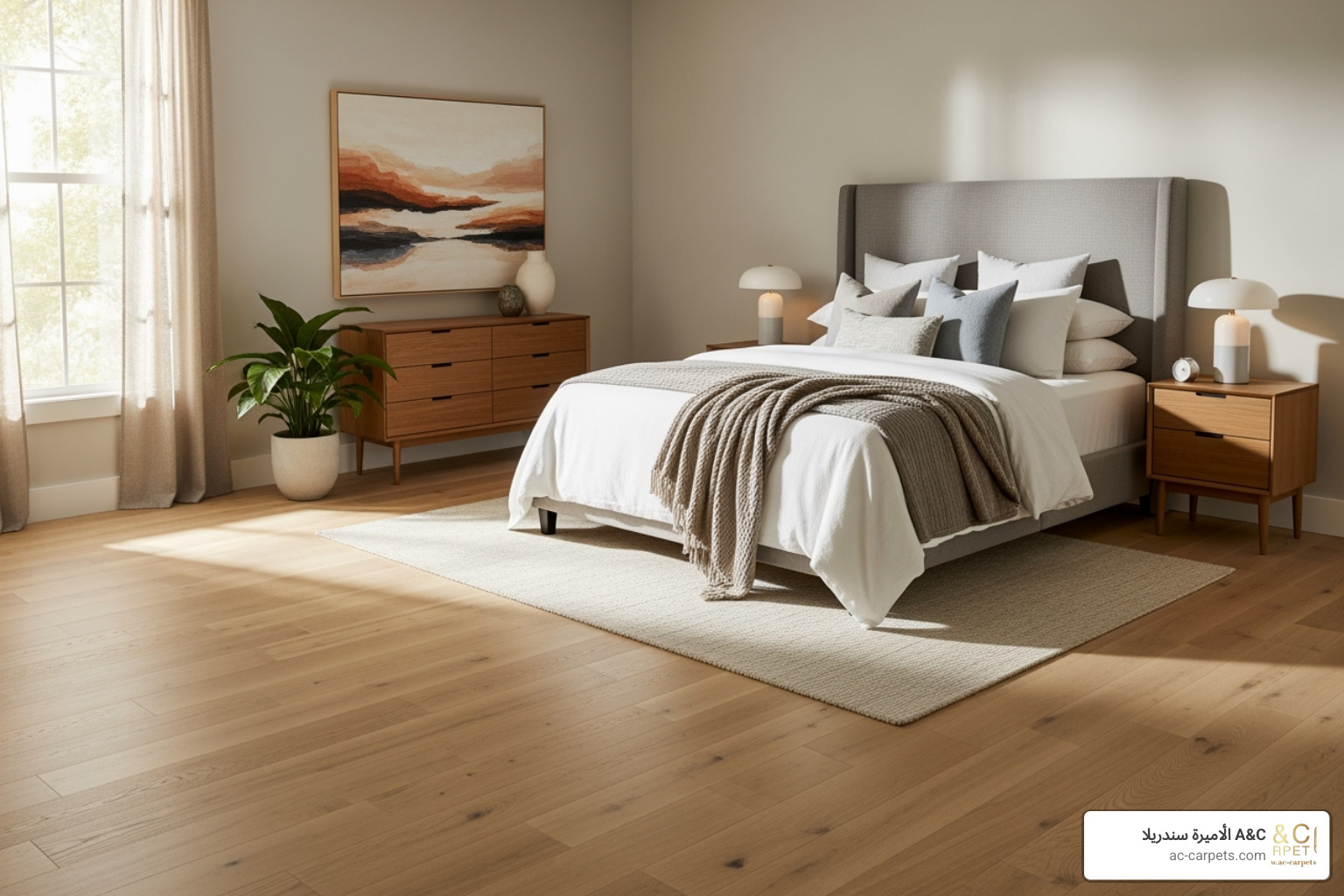
How to Choose Scratch Resistant Floors in Wood
The secret to durable wood flooring is strategic selection, as not all wood is equally hard.
The Janka Hardness Scale is your best friend here. This test measures the force needed to embed a small steel ball into wood. Higher numbers mean harder, more scratch-resistant wood.
Hickory is one of the hardest commercially available woods, making it an excellent choice for scratch resistant floors. Hard maple and white oak are also stellar performers. Softer woods like pine will show dings and scratches more easily.
Crucially, the finish matters even more than the wood species. The finish is the floor’s primary defense against daily wear and tear.
Factory-applied finishes have revolutionized wood flooring durability. Many modern engineered hardwoods come with tough finishes incorporating aluminum oxide—the same super-hard material used in luxury vinyl. These finishes are applied in multiple, UV-cured layers, creating a resilient surface.
If you’re using solid hardwood, look for high-quality polyurethane finishes. Oil-based options tend to be harder than water-based ones.
A pro tip: choose a matte or low-gloss finish over high-gloss. A shiny finish acts like a magnifying glass for every tiny scratch, while a matte finish is more forgiving and hides minor imperfections.
Engineered hardwood often has an advantage because it typically comes with these advanced factory finishes. When selecting engineered wood, pay attention to the wear layer thickness—that’s the real wood veneer that can be refinished if needed.
The combination of a hard wood species with a high-quality, scratch resistant finish can give you floors that are both gorgeous and remarkably tough.
For more detailed strategies on protecting your wood floor investment, explore our comprehensive guide on The Best Way to Keep Your Hardwood Floor Scratch-Resistant.
Protecting Your Investment: Universal Floor Care Tips
Even the toughest scratch resistant floors need some TLC to stay looking their best. A little preventative care goes a long way in keeping them beautiful for years.
Most floor scratches are preventable with simple habits. The most effective solutions are often the easiest.
Felt pads on furniture legs are essential. This inexpensive step can save you hundreds in repair costs. Every chair, table, and piece of furniture that touches your floor should have them.
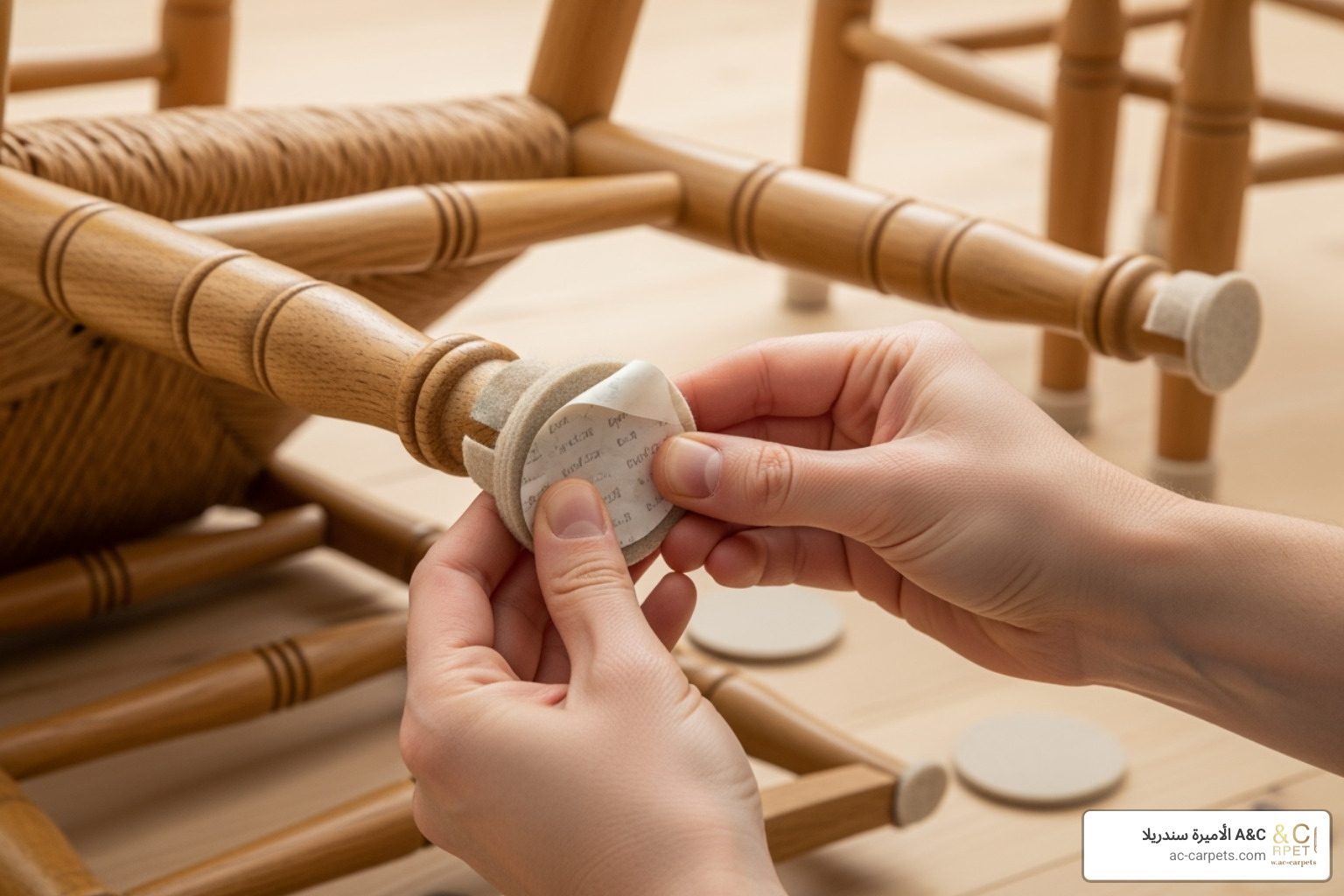
Area rugs and runners are like insurance for your floors. Place them in hallways, under play areas, and anywhere you see heavy foot traffic to absorb daily abuse.
Most scratches come from tiny particles of sand and grit. Quality doormats at every entrance are your first line of defense. Place them both inside and outside your doors for maximum protection.
Regular sweeping or vacuuming is crucial. Innocent-looking dust bunnies contain abrasive particles that act like sandpaper when walked on. A quick daily sweep in high-traffic areas prevents these particles from grinding into your floor’s surface.
For pet owners, keeping your furry friend’s nails trimmed is non-negotiable. Long claws can scratch even the most durable floors.
When rearranging furniture, remember this golden rule: lift, don’t drag. Even with felt pads, dragging heavy pieces can cause deep gouges. For heavy items, furniture sliders are worth their weight in gold.
These simple habits work for every type of flooring. Your floors—and your wallet—will thank you for the extra care.
For more detailed guidance on maintaining different flooring types, explore our comprehensive resources on Scratch resistant floors.
Frequently Asked Questions about Scratch-Resistant Flooring
After years of helping homeowners choose the perfect flooring, I’ve noticed the same questions come up time and again. Here are the answers to the most common concerns about scratch resistant floors.
What is the single best type of flooring for scratch resistance?
Based purely on scratch resistance, porcelain tile is the champion. Unglazed porcelain is nearly indestructible due to its extreme hardness and dense composition, making it highly resistant to damage from force or sharp objects.
I’ve seen porcelain floors in busy restaurants that still look pristine after years of heavy traffic. The durability is remarkable.
However, the “best” flooring depends on your needs. If you prioritize a softer feel for a bedroom, porcelain might not be the ideal choice, despite its durability.
What is a “wear layer” and why is it important?
The wear layer is a transparent top coating that acts as a bodyguard for your floor. It protects the design layer from scratches, scuffs, dents, and sun-induced fading.
For luxury vinyl flooring, we measure this protective layer in “mils” (thousandths of an inch). A standard residential floor typically has a 12 mil wear layer, but I always recommend going thicker—20 mil or higher—for homes with kids, pets, or heavy foot traffic.
With laminate flooring, the wear layer’s toughness is shown through the AC rating system. The higher the AC number, the more punishment your floor can take.
This protective layer is what determines whether your scratch resistant floors will still look great in five years or start showing their age much sooner.
How do pets and children impact my flooring choice?
Pets and children bring joy, but they also present unique challenges for your floors, changing your flooring needs significantly.
Increased foot traffic is just the beginning. There are also potential scratches and spills—untrimmed pet claws, dragged toys, or the occasional pet accident.
The good news? This is exactly why scratch resistant floors were invented! For families with pets and children, I almost always steer them toward Luxury Vinyl Plank (LVP) with a thick wear layer and solid SPC core, or tile options. These materials handle muddy paw prints, dropped toys, and the general chaos of a busy home.
Water resistance becomes crucial too, because spills are inevitable. You need flooring that can handle life’s messiness without permanent damage or constant worry.
Conclusion
Choosing scratch resistant floors is easier now that you understand the options, from the toughness of porcelain tile and the balance of luxury vinyl to the appeal of engineered hardwood. You’re equipped to make a confident decision.
There’s no single “perfect” flooring for everyone. Your ideal choice is where durability meets your style and budget. For homes with active kids or pets, durability is a top priority.
While no floor is completely “scratch-proof,” the right scratch resistant floors paired with smart care habits will keep your investment looking beautiful for decades. Simple steps like adding felt pads to furniture and keeping pet nails trimmed make a world of difference.
At الأميرة سندريلا A&C, we’ve built our reputation on understanding what modern Egyptian families, businesses, and hospitality spaces truly need. We’re not just selling floors; we’re creating solutions that work in real life. Our innovative carpet alternatives and flooring options are designed to be neat and practical, standing up to life while maintaining their sophisticated appearance.
Whether you’re renovating your home, updating your office, or designing a hotel, we’re here to guide you. Our team understands the unique challenges of our climate and culture, ensuring every recommendation is custom to perform exceptionally in Egyptian conditions.
Ready to transform your space with flooring that combines beauty, durability, and peace of mind? We’d love to help. Explore our neat and practical flooring alternatives and see how we can bring confidence and style to your project.
